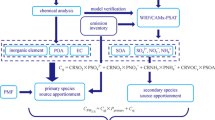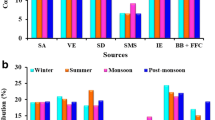Abstract
The marginal utility of using organic compounds’ data to the Positive Matrix Factorization (PMF) model in addition to the conventional measurement data of inorganic ions, elements, and organic carbon (OC) and elemental carbon (EC) was evaluated. Three cases of input data were used; (1) case 1: conventional inorganic ions, elements, OC and EC, (2) case 2: case 1 with organic compounds, (3) case 3: same as case 1 except adding levoglucosan. The PM2.5 measurement data in Seoul from October 2012 to September 2013 were used. The performance evaluation parameters determined 9 sources for case 1 and case 3 and 10 sources for case 2. Case 2 with organic compounds not only subdivided biomass burning into local and transported biomass burning but also identified biogenic sources which could not be identified in case 1 and case 3. Furthermore, in case 2, it was possible to apply diagnostic ratios on the polycyclic aromatic hydrocarbons (PAHs) to check the validity of the proposed factor characteristics. The PMF modeling results were compared to the Solver for Mixture Problem (SMP) modeling result which was separately carried out by Kim et al. (2016) using the data set of case 2. The SMP modeling was also able to identify local and transported biomass burning sources. However, it was not possible to classify biogenic source that was identifiable through the PMF modeling. Thus, though it takes extra effort to obtain organic speciation data, applying organic compounds in the PMF modeling can provide more accurate source identification and quantitative contribution estimation.

source profile


source profile


source profile

Similar content being viewed by others
Data availability
Raw data of specific analyzed species were generated at the Korea Institute of Science and Technology. Derived data supporting the findings of this study are available from the corresponding author on request.
References
Bi X, Sheng G, Peng PA, Chen Y, Zhang Z, Fu J (2003) Distribution of particulate-and vapor-phase n-alkanes and polycyclic aromatic hydrocarbons in urban atmosphere of Guangzhou. China Atmos Environ 37(2):289–298. https://doi.org/10.1016/S1352-2310(02)00832-4
Brown SG, Eberly S, Paatero P, Norris GA (2015) Methods for estimating uncertainty in pmf solutions: examples with ambient air and water quality data and guidance on reporting pmf results. Sci Total Environ 518–519:626–635. https://doi.org/10.1016/j.scitotenv.2015.01.022
Choi NR, Lee SP, Lee JY, Jung CH, Kim YP (2016) Speciation and source identification of organic compounds in PM10 over Seoul, South Korea. Chemosphere 144:1589–1596. https://doi.org/10.1016/j.chemosphere.2015.10.041
Galarneau E (2008) Source specificity and atmospheric processing of airborne PAHs: implications for source apportionment. Atmos Environ 42(35):8139–8149. https://doi.org/10.1016/j.atmosenv.2008.07.025
Guha A, Gentner DR, Weber RJ, Provencal R, Goldstein AH (2015) Source apportionment of methane and nitrous oxide in California’s San Joaquin Valley at CalNex 2010 via positive matrix factorization. Atmos Chem Phys 15:12043–12063. https://doi.org/10.5194/acp-15-12043-2015
Guo H, Lee SC, Ho KF, Wang XM, Zou SC (2003) Particle-associated polycyclic aromatic hydrocarbons in urban air of Hong Kong. Atmos Environ 37(38):5307–5317. https://doi.org/10.1016/j.atmosenv.2003.09.011
Han S, Lee JY, Le J, Heo J-B, Jung CH, Kim E-S, Kim YP (2018) Estimation of the source contributions for carbonaceous aerosols at a background site in Korea. Asian J Atmos Environ 12(4):311–325. https://doi.org/10.5572/ajae.2018.12.4.311
Han S, Lee JY, Lee J, Heo J-B, Kim YP (2019) Temporal trend of the major contributors for the particulate polycyclic aromatic hydrocarbons (PAHs) in Seoul. Aerosol Air Qual Res 19(2):318–330. https://doi.org/10.4209/aaqr.2018.06.0231
Hedberg E, Kristensson A, Ohlsson C, Johnsson P, Swietlicki E, Vesely V, Wideqvist U, Westerholm R (2002) Chemical and physical characterization of emission from birch wood combustion in a wood stove. Atmos Environ 36:4823–4837. https://doi.org/10.1016/S1352-2310(02)00417-X
Heo JB, Hopke P, Yi SM (2009) Source apportionment of PM2.5 in Seoul, Korea. Atmos Chem Phys 9(14):4957–4971. https://doi.org/10.5194/acp-9-4957-2009
Heo JB, Dugler M, Olson MR, McGinnis JE, Shelton BR, Matsunaga A, Sioutas C, Schauer JJ (2013) Source apportionments of PM2.5 organic carbon using molecular marker positive matrix factorization and comparison of results from different receptor models. Atmos Environ 89:207–215. https://doi.org/10.1016/j.atmosenv.2013.03.004
Jaeckels JM, Bae M-S, Schauer JJ (2007) Positive matrix factorization (PMF) analysis of molecular marker measurements to quantify the sources of organic aerosols. Environ Sci Technol 41:5763–5769. https://doi.org/10.1021/es062536b
Jung DB, Cho YS, Kim IS, Lee JY, Kim YP (2015) Impact of energy consumption in Northeast Asia to the particulate PAHs levels and composition at Seoul. Aerosol Air Qual Res 15(6):2190–2199. https://doi.org/10.4209/aaqr.2015.01.0038
Kang CM, Lee HS, Kang BW, Lee SK, Sunwoo Y (2004) Chemical characteristics of acidic gas pollutants and PM2.5 species during hazy episodes in Seoul, South Korea. Atmos Environ 38(28):4749–4760. https://doi.org/10.1016/j.atmosenv.2004.05.007
Kim BM (2013) Development of a new SMP model satisfying all known physical constraints in environmental application. Chemom Intell Lab Syst 121:57–65. https://doi.org/10.1016/j.chemolab.2012.11.020
Kim BM, Seo JH, Kim JY, Kim YM (2016) Transported vs. local contributions from secondary and biomass burning sources to PM2.5. Atmos Environ 144:24–36. https://doi.org/10.1016/j.atmosenv.2016.08.072
Lee E, Chan CK, Paatero P (1999) Application of positive matrix factorization in source apportionment of particulate pollutants in hong kong. Atmos Environ 33:3201–3212. https://doi.org/10.1016/S1352-2310(99)00113-2
Lee JH, Hopke PK (2006) Apportioning sources of PM2.5 in St. Louis, MO using speciation trends network data. Atmos Environ 40:360–377. https://doi.org/10.1016/j.atmosenv.2005.11.074
Lee JY, Kim YP (2007) (2007) Source apportionment of the particulate PAHs at Seoul, Korea: impact of long-range transport to a megacity. Atmos Chem Phys 7(13):3587–3596. https://doi.org/10.5194/acp-7-3587-2007
Lin P, Engling G, Yu JZ (2010) (2010) Humic-like substances in fresh emissions of rice straw burning and in ambient aerosols in the Pearl River Delta Region. China Atmos Chem Phys 10:6487–6500. https://doi.org/10.5194/acp-10-6487-2010
Liu B, Xue Z, Zhu X, Jia C (2017) Long-term trends (1990–2014), health risks, and sources of atmospheric polycyclic aromatic hydrocarbons (PAHs) in the U.S. Environ Pollut 220:1171–1179
Lough GC, Schauer JJ, Park JS, Shafer MM, DeMinter JT, Weinstin JP (2005) Emissions of metals associated with motor vehicle roadways. Environ Sci Technol 39(3):826–836. https://doi.org/10.1021/es048715f
Na K, Kim YP (2007) Chemical Mass Balance Receptor Model applied to ambient C2–C9 VOC concentration in Seoul, Korea: effect of chemical reaction losses. Atmos Environ 41(31):6715–6728. https://doi.org/10.1016/j.atmosenv.2007.04.054
Norris, G., Duvall, R., Brown, S., and Bai, S. (2014) EPA positive matrix factorization (PMF) 5.0 fundamentals and user guide prepared for the us environmental protection agency office of research and development. Washington DC, DC EPA/60/R-14/108.
Oh MS, Lee TJ, Kim DS (2011) Quantitative source apportionment of size-segregated particulate matter at urbanized local site in Korea. Aerosol Air Qual Res 11:247–264. https://doi.org/10.4209/aaqr.2010.11.0099
Olivera C, Martins N, Tavares J, Pio C, Cerqueria M, Matos M, Silva H, Olivera C, Camöes F (2011) Size distribution of polycyclic aromatic hydrocarbons in a roadway tunnel in Lisbon, Portugal. Chemosphere 83:1588–1596. https://doi.org/10.1016/j.chemosphere.2011.01.011
Paatero P (1997) Least squares formulation of robust non-negative factor analysis. Chemom Intell Lab Syst 37(1):23–35. https://doi.org/10.1016/S0169-7439(96)00044-5
Paatero P, Tapper U (1994) Positive matrix factorization: a non-negative factor model with optimal utilization of error estimates of data values. Environmetrics 5:111–126. https://doi.org/10.1002/env.3170050203
Park EH, Heo JB, Kim H, Yi SM (2020) Long term trends of chemical constituents and source contributions of PM2.5 in Seoul. Chemosphere 251:126371. https://doi.org/10.1016/j.chemosphere.2020.126371
Park MB, Lee TJ, Lee ES, Kim DS (2019) Enhancing source identification of hourly PM2.5 data in Seoul based on a dataset segmentation scheme by positive matrix factorization (PMF). Atmos Pollut Res 10:1042–1059. https://doi.org/10.1016/j.apr.2019.01.013
Park SS, Kim YJ (2005) Source contributions to fine particulate matter in an urban atmosphere. Chemosphere 59(2):217–226. https://doi.org/10.1016/j.chemosphere.2004.11.001
Rogge WF, Hildemann LM, Mazurek MA, Cass GR, Simoneit BR (1997) Sources of fine organic aerosol 8 Boilers burning No. 2 distillate fuel oil. Environ Science Technol 31(10):2731–2737. https://doi.org/10.1021/es9609563
Schauer JJ, Rogge WF, Hildemann LM, Mazurek MA, Cass GR, Simoneit BR (1996) Source apportionment of airborne particulate matter using organic compounds as tracers. Atmos Environ 30:3837–3855. https://doi.org/10.1016/1352-2310(96)00085-4
Seinfeld JH, Pandis SN (2016) Atmospheric chemistry and physics: from air pollution to climate change, 3rd edn. John Wiley & Sons Inc, Hoboken, New Jersey, USA
Sicre MA, Peltzer ET (2004) Lipid geochemistry of remote aerosols from the southwestern Pacific Ocean sector. Atmos Environ 38(11):1615–1624. https://doi.org/10.1016/j.atmosenv.2003.12.012
Simcik MF, Eisenreich SJ, Lioy PJ (1999) Source apportionment and source/sink relationships of PAHs in the coastal atmosphere of Chicago and Lake Michigan. Atmos Environ 33(30):5071–5079. https://doi.org/10.1016/S1352-2310(99)00233-2
Simoneit BR (1985) Application of molecular marker analysis to vehicular exhaust for source reconciliations. Int J Environ Anal Chem 22:203–223. https://doi.org/10.1080/03067318508076422
Wang Q, He X, Huang XH, Griffith SM, Feng Y, Zhang T, Zhang Q, Wu D, Yu JZ (2017) Impact of secondary organic aerosol tracers on tracer-based source apportionment of organic carbon and PM2.5: a case study in the Pearl River Delta, China. ACS Earth Space Chem 1(9):562–571. https://doi.org/10.1021/acsearthspacechem.7b00088
Watson JG (1984) Overview of receptor model principles. J Air Pollut Control Assoc 34:619–623. https://doi.org/10.1080/00022470.1984.10465780
Watson, J., Chow, J., Fujita, E. (2004) Protocol for applying and validating the CMB model for PM2.5 and VOC, US Environmental Protection Agency.
Acknowledgements
This study was supported in part by the National Institute of Environmental Research and also by Technology Development Program to Solve Climate Changes funded by the Ministry of Science and ICT (NRF-2019M1A2A2103953), Korea.
Author information
Authors and Affiliations
Corresponding author
Additional information
Publisher's note
Springer Nature remains neutral with regard to jurisdictional claims in published maps and institutional affiliations.
Supplementary Information
Below is the link to the electronic supplementary material.
Rights and permissions
About this article
Cite this article
Shin, S.M., Kim, J.Y., Lee, J.Y. et al. Enhancement of modeling performance by including organic markers to the PMF modeling for the PM2.5 at Seoul. Air Qual Atmos Health 15, 91–104 (2022). https://doi.org/10.1007/s11869-021-01087-7
Received:
Accepted:
Published:
Issue Date:
DOI: https://doi.org/10.1007/s11869-021-01087-7




